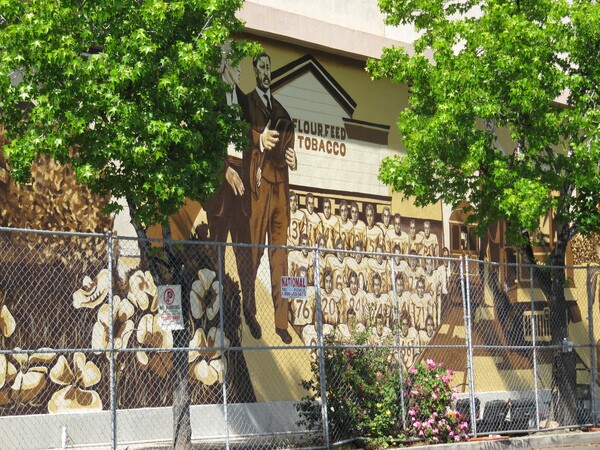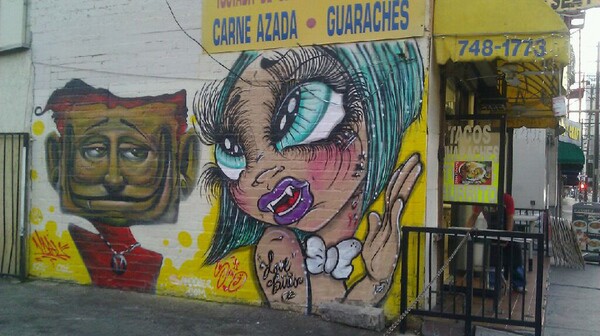A 'Rush' to Mural Judgement: City Council Moves Forward with Art Policies

The first round of motions that will revive murals in Los Angeles, allowing ordinances to be drafted, were passed by the city council on Wednesday. Language to create a "Vintage Mural" permitting system that would help protect established works on private property will be created and later presented to the council for final approval.
Another set of ordinances, that will allow new smaller works, were recommended to move forward to a workshop stage, allowing a broader scope of artists and administrators to have decisive input on the future of murals.
It happens that this week, two separate works from two very different schools of styles in muralism illustrate why a varied set of ordinances are needed.

The "History of Highland Park," a mural completed in 1978, will have a restoration dedication ceremony Saturday, October 22 at 10 a.m. After years of collaboration and negotiation between AT&T, the Social And Public Art Resource Center (SPARC), and District 14 Councilmember Jose Huizar, the 125-foot-long mural seen on the walls of an AT&T building (1207 N. Avenue 56) will be reintroduced to the public.
The restoration was funded by AT&T, and led by SPARC's Judy Baca--one of the four original artists who painted the now-iconic community mural.
This work would fall under the "Vintage Mural" permit, allowing pieces to be recognized, and prevent buildings owners to be cited for a works painted before there was any official policy. For some pieces that have been important to a community, works can be saved, hopefully restored from destructive elements of weather and tagging, and presented back to the neighborhood with appropriate fanfare and speeches.

Then there is the style of mural that would have benefited from the to-be developed Time/Place/Manner ordinance, allowing smaller works to be created on private property. One example was painted over the same week it was completed.
At a small downtown Mexican restaurant at 12th and Wall in downtown Los Angeles, a graffiti-style work by Sand Oner and Vyal One was completed with permission of the business owner. Oner, who goes by Sand One approached the restaurant and offered the work for free.
"He was excited," she said by phone. "He fed us, too, so we got paid in tacos and burritos."
When Sand One went to follow up, she said the restaurant owner was angry since the mural prompted the LAPD to inform him he could be fined. The owner was also asked, "Why are you allowing vandalism on your walls?" she explained..
Calls to the LAPD about the mural were not returned as of this writing. (It is the undermanned Building and Safety department that cites buildings with murals, not LAPD.)
"I think it was the owner who cracked under threat of fines" tweeted Vyal, the other artist on the project. The owner was intimidated, reasoned Daniel Lahoda of Jetset Graffiti.
An ethnic-based business being targeted to comply or being told they risk being cited, with no official ordinances in place, is problematic. Owners depending on LAPD for emergency response in a harsher part of town makes them unwilling to be art advocates.
Granted, Sand One admits to having created unauthorized works for "the rush," yet credits art for pulling her away from gang culture, sometimes the only option for a 13-year-old being raised in East Los Angeles.
"It changes the way you think," said Sand One, and who at 20, is becoming known on the street and in galleries for female figures.
Her jump from graff artist to street artist is a "transition period," she said. Like others, Sand One finds herself with one foot still rebelling while stepping toward being a street-style fine artist.
As for the pressure street artists experience from law enforcement, it has the attention of city politicians.
Citations should be an administrative process, and not a criminal process, said Council member Huizar during Wednesday's meeting. Councilmember Ed Reyes resolved to look closer at the claims of the criminalization of street artists who make murals.
The city can now more proactively solve issues with murals, Reyes told KCET after the meeting. "We have a set of ordinances that gives us the ability to create policy," he said. "And through that, we can see how artists can create without the fear of being arrested."
Just as important, the ordinances allow a property or business owner to make art happen without the fear of being threatened with a citation.


